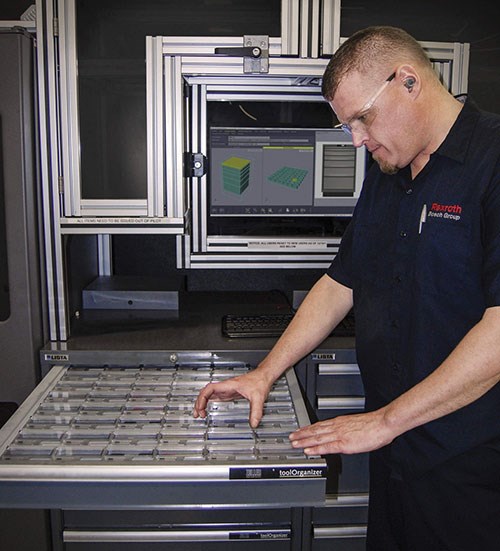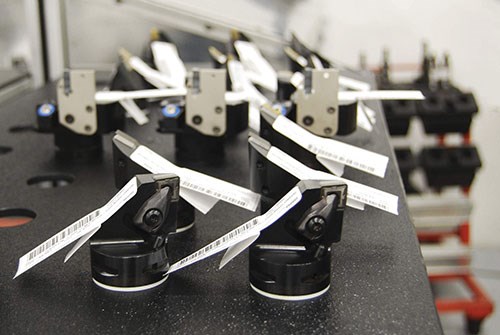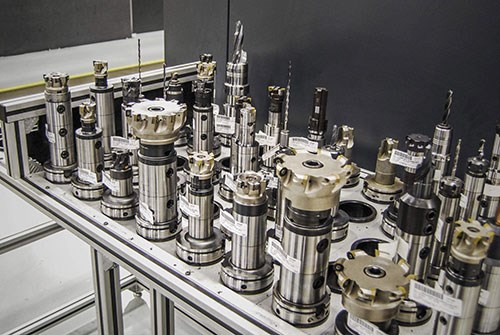Tool Management System Pumps up Plant-Wide Communication
Zoller’s Tool Management System helped Bosch Rexroth streamline tool design, product manufacturing and tool quality. As a result, the plant has seen a reduction in quality issues and an increase in production efficiency.
The saying “too many cooks spoil the broth” isn’t something that only applies to the culinary arts. It can also relate to manufacturing operations. At its Fountain Inn, South Carolina, plant, Bosch Rexroth was using multiple software suites for tool management, in turn causing communication challenges. By investing in the Tool Management System (TMS) from Zoller (Ann Arbor, Michigan), the company was able to streamline its tool management system to a single suite to reduce quality issues and improve efficiency.
At its Fountain Inn plant, Bosch Rexroth produces many different axial piston hydraulic pumps and valve housings for its drive products used in heavy equipment and agricultural applications. The plant has two production buildings with more than 90 CNC machine tools—mostly DMG and Mori Seiki machining centers—operating 24/7. Iron and steel materials are received from foundry suppliers and machined on the four- and five-axis machining centers, which feature large tool storage capacities.
Due to the complex design of the products Bosch Rexroth manufactures, the machining centers make use of an expansive cutting tool inventory, which comprises mostly special designs that produce multiple diameters and other complex part features. These tools must be available immediately when needed. Also, it is essential for the company to keep accurate, timely track of engineering changes, item availability, tool regrinds over the tool inventory and other indirect materials used on the production floor.
Bosch Rexroth already had Zoller tool presetters in the plants to provide accurate tool offsets and avoid crashes and other manufacturing problems. However, the company was also using another software to run its engineering tool management. The Zoller software reported on the reality of the tools while the engineering software provided direction on how to make the tool. This was problematic because the toolsetter operators worked with one system and the engineers worked with another. It became a challenge to make sure they could communicate with each other.
The company’s Technical Functions (TEF) department decided it was necessary to streamline the tool management system to minimize tool and process cost, improve throughput and ensure consistently high part quality. Looking at all the options, Bosch Rexroth decided to invest in the Zoller TMS, reducing what had been three software suites—design, inventory and measuring—to a single suite. Now, just one software manages the engineering, toolsetting and tool management, and only a single set of data is available to operators, tool setters and engineers. The Zoller TMS Silver package is a single suite of software that is designed to combine effective warehouse management and standardized production data management with organized tool management.
All information is managed by the single Zoller TMS database, yet tools can be managed from the office, CNC machines, Zoller Tool Organizers, vending machines and directly from the presetting and measuring machine. Since the system is modular, its functionality can be extended step by step going forward. Right now, Bosch Rexroth takes advantage of stored tool data and DIN4000 article characteristic information to optimize inventory cost control as well as tool production.
For the TEF department, the tool storage management module has been particularly useful, because it enables managing complete tool assemblies and components while keeping accessory inventories up to date. The storage location management in the warehouse includes a 3D design kit that enables current stock to be displayed three-dimensionally and items to be assigned to a virtual bin location. The database provides an overview of each item’s location, where it is in circulation, and the balance on hand in stores.
Feedback on circulation and stock levels are available at the push of a button. This is a major asset for increasing manufacturing transparency, which helps Bosch Rexroth run production economically around the clock when needed. The simple import and export of tool usage data also helps ensure quality and integration of various machines and departments.
There is no longer redundant data storage in multiple locations around the two production buildings—if an engineer makes a change to the tool design, it is visible to everyone. Previously, when the engineer made an update, that person would have to tell the tool setter to update his or her record as well, which took time and inevitably included some inaccuracy, says Dave Morley, Zoller product manager.
The company has started measuring every tool feature and adding tolerance information to the database, he says. Using the complete record, the engineer can now see the history of the tool’s setup measurement results. For example, the engineer can now know if the tool tolerance has been in the mid-range most of the time or if it has ever approached the limits. Without the complete record, this information would have been unavailable, making it difficult to meaningfully improve the tool design or features, Mr. Morley says.
Since engineers can now access the statistical measurement results for each tool assembly at a desk or the machine tool, they can make timely corrections or improvements to the tool design, which improves machining capacity, cycle times and part quality. It also helps identify and address the root cause of machining quality issues.
Bosch Rexroth has strict rules that a tool cannot be passed to manufacturing if it is out of tolerance; however, this has become less of an issue since engineers can now investigate any tool issues and look for a solution before cutting even starts. So far, tool breakage at Bosch Rexroth has been curbed from an average of 15 to fewer than eight tools per 1,000 parts produced.
The TEF department also wanted to better understand how the tools are used in the machines. The engineer can search the tool information through the TMS at a desk or at the presetters to make the connection between how the tool is set and how it performs. In terms of performance, this information is collected as the operator scans his or her badge, scans the machine identity and inputs the reason code for the tool change. It is now transparent which tools are changed the most and for what reasons.
The tool assembly history provided by the TMS is used to help optimize and control tool component inventory. Another way the tool management software controls inventory is through access to vending machines. At vending machines, users can look up the bill of material for any tool assembly and be accurately guided to the required components.
To keep designed tools organized, Bosch Rexroth uses the Zoller Tool Organizer to know the exact location of each and every tool or component. Flashing LEDs clearly indicate location of needed items, providing a fail-safe check-out system. Also, the Tool Organizer is interfaced directly to Zoller stock management.
As a result of Zoller’s TMS, the Bosch Rexroth plant has seen a reduction in quality issues and an increase in production efficiency. The TMS has also eliminated centers of “tribal knowledge,” meaning information no longer resides with just one or two people. Engineers are truly in charge of the tool.
Related Content
How to Evaluate Measurement Uncertainty
Manufacturing and measurement are closely coupled. An important consideration for the use of measurement results is the associated measurement uncertainty. This article describes common metrology terms and provides an example uncertainty analysis.
Read MoreChoosing the Correct Gage Type for Groove Inspection
Grooves play a critical functional role for seal rings and retainer rings, so good gaging practices are a must.
Read MoreParts and Programs: Setup for Success
Tips for program and work setups that can simplify adjustments and troubleshooting.
Read MoreProcess Control — Leveraging Machine Shop Connectivity in Real Time
Renishaw Central, the company’s new end-to-end process control software, offers a new methodology for producing families of parts through actionable data.
Read MoreRead Next
Registration Now Open for the Precision Machining Technology Show (PMTS) 2025
The precision machining industry’s premier event returns to Cleveland, OH, April 1-3.
Read More5 Rules of Thumb for Buying CNC Machine Tools
Use these tips to carefully plan your machine tool purchases and to avoid regretting your decision later.
Read MoreRego-Fix’s Center for Machining Excellence Promotes Collaboration
The new space includes a showroom, office spaces and an auditorium that will enhance its work with its technical partners.
Read More


















.jpg;maxWidth=300;quality=90)





.jpg;maxWidth=300;quality=90)









